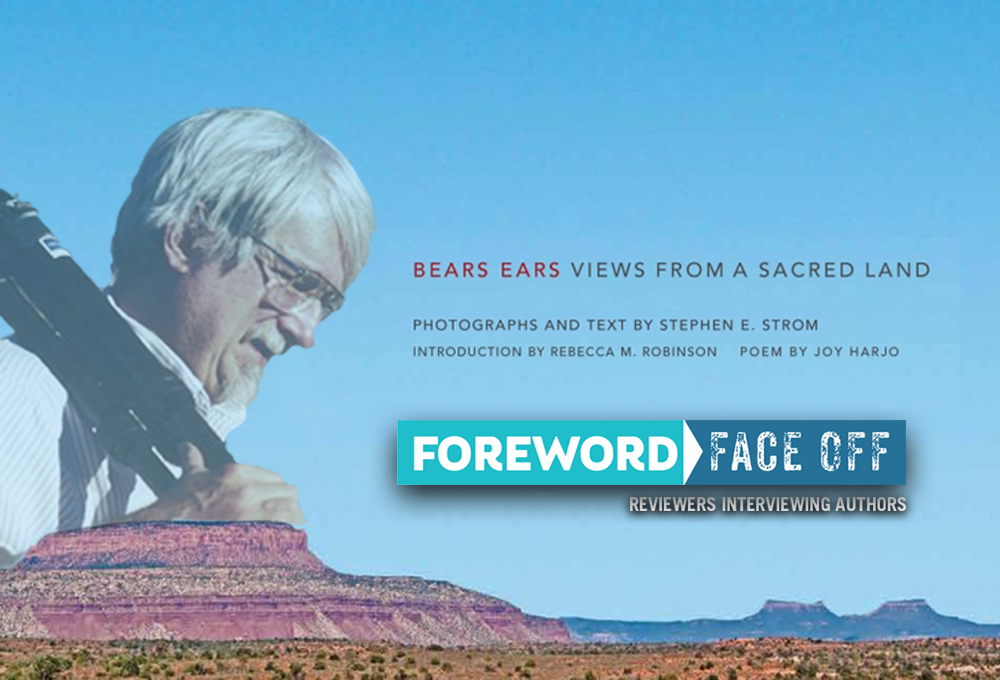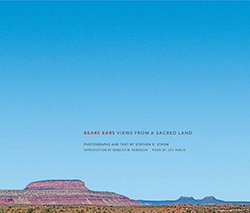Interview with Stephen Strom, Author/Photographer of Bears Ears

Reviewer Rachel Jagareski Talks Pristine Wilderness with Stephen E. Strom, Author/Photographer of Bears Ears: Views from a Sacred Land
While not tech savvy, since arriving in the Oval Office, President Trump has shown great proficiency in the use of the Mac prompt ⌘Z (⤺). Indeed, he seems hellbent to undo as many Obama-era initiatives as possible—health care, trade agreements, Deferred Action for Childhood Arrivals (DACA) program, Paris Agreement, Iran nuclear deal, and on and on. With climate change in mind, we’re especially distressed by the president’s desire to expand coal, oil, and gas development on public land, and to kill environmental initiatives that put limits on the energy industry. Trump and EPA chief Scott Pruitt detest the fact that Obama created or expanded twenty-nine national monuments during his eight years in office, representing more than 550 million more acres under federal protection.

The Bears Ears National Monument in the southeastern corner of Utah was one of those twenty-nine. Today’s Face Off features Stephen E. Strom, author/photographer of Bears Ears: Views from a Sacred Land, “a visual and literary introduction to this singular landscape, with a thorough textual tour of its social and geological history alongside Strom’s dazzling color photographs,” in the words of Rachel Jagareski, in her glowing review of the title in the May/June issue of Foreword Reviews.
For reasons political, environmental, aesthetical, and literary, we asked Jagareski to chase down Strom for a Face Off, and the two seemed to get along splendidly. Check out the week’s Special Features and Featured Reviews at the end.
Though categorized as a photography and nature title, this book can be enjoyed on so many levels. The photographs document a spectacular and special landscape that you and Rebecca M. Robinson describe so evocatively in your text. One learns so much about Bears Ears’ historical, geological, cultural, and spiritual background, and it is accented with wonderful quotes from Wallace Stegner to Theodore Roosevelt. Additionally, Joy Harjo’s powerful poem is a benediction over the whole project that warns of how much might be lost if this area is not protected. How did this literary and artistic collaboration come about? Did the book start as a photography book and then evolve into something more or did you envision this multi-layered project at the outset?
My family and I have been visiting the Four Corners area on and off for four decades. After my wife passed away in 2014, our family gathered together in remembrance of her at Cedar Mesa in Utah. That’s when my journalist granddaughter Rebecca and I tossed around the idea of working on a collaborative project about the canyonlands of southeastern Utah. We began to set up interviews in January 2015 with over 80 local residents, tribal leaders, environmentalists, ranchers, and others—anyone with a voice—to understand the different views of those who both support and oppose the designation of the Bears Ears monument. Our intent was to identify common ground between the various people who feel a deep cultural and spiritual connection to this land and use this as a starting point to move forward with the public conversation about its stewardship in the future.
Three themes emerged from our research: first, many of those interviewed feel that their voices have not been heard or respected; second, many residents of San Juan County, where Bears Ears is located, feel great uncertainty about the local economy; and third, whether people feel strongly that the monument designation was either a federal land grab OR was a long overdue granting of tribal voices in federal land management—all believe the land to be of deep cultural, even spiritual significance.
This photography book primarily offers a visual representation of Bears Ears and accompanies the other book that I and Rebecca have collaborated on entitled Voices from Bears Ears: Seeking Common Ground on Sacred Land. This second volume will be published later this year by the University of Arizona Press. The present book is intended as more of a visual journey across these lands, but we worked on both book projects in the same time frame.
I knew Joy Harjo from the time when my wife and I taught on a Navajo Reservation and we collaborated previously on her 1989 poetry book Secrets from the Center of the World. She graciously provided the poem for this book.
Your photographs capture such distinctly different aspects of the Bears Ears various rock formations and landscape. The stunning variations in lighting, texture, vantage point, seasonal changes, and color show that you must have spent quite a long time capturing these diverse images. Can you describe how long it took you to shoot the photos for this book and what types of challenges were involved?
Some photographs date back to the 1980s. I have long felt a powerful connection to the Red Rock country and when I was younger, enjoyed many hikes and climbs into its remoter areas, lugging my large 4 by 5 cameras and long focal length lenses. The bulk of the images are contemporary, however, and some were aerial shots taken during several plane flights over the Bears Ears area.
Some of your photographs reminded me of the work of Brett Weston, others of Minor White and Georgia O’Keeffe. And still others look like images sent back by the Mars rover! Who are some photographers and visual artists that have inspired you?
I have been inspired by all of the names you mention above, and would add Edward Weston, Harry Callahan, and Frederick Sommer to the list. The mention of the Mars Rover is also noted. My years as a research astronomer certainly included viewing a great many images sent back by the Mars and Earth orbiters and rovers and I no doubt have unconsciously evoked some of the lighting and imagery in my photography.
Your essay about billions of years of Earth’s formation and evolution of life and about how much of it is reflected throughout the Bears Ears geology was quite an education. You masterfully explained so many scientific concepts in easily understood terms and with lyrical prose. While it wasn’t surprising to learn of your former career as an astronomer given the ease with which you wrote about these topics, I had imagined that you worked in the arts. Am I biased in thinking that scientists are not also creative types? Do you think astronomers are particularly imbued with poetic and artistic sensibilities after seeing so many wonders through their telescopes?
I think that there is lots of intersection between artists and scientists: good artists and scientists both experiment a great deal in their work, whether they use ideas, art materials, or their own bodies, as tools. Measurement and observation are the foundation of scientific exploration, but I think most artists keep challenging and changing their perspective and the way they observe and record the world and their emotional reactions to it.
I grew up with a photographer dad in a home with a darkroom, so I always had a familiarity with cameras and felt comfortable using photography as a recording medium during my research career. However, once I began seriously studying photography I began to see things through the lens less analytically and more emotionally. When I am photographing a landscape I try to experiment in creative ways to evoke the spirit of the place. I find myself subconsciously reacting to chromatic and sculptural rhythms. My mind is unusually sensitive to pattern—whether in a landscape or in a seemingly incoherent set of measurements.
Before reading your book I hadn’t known that the 2016 designation of Bears Ears National Monument by President Obama represented the very first time in US history that the federal government would be partners with an Inter-Tribal Coalition in setting land use policies and regulations for public lands. What forces were at work to make this landmark policy shift come about? Do you think that we will see more of these collaborative federal land use management policies in the future?
The initial work in securing protection for Bears Ears lands came from a group of Utah Navajo (Utah Dine Bikeyah) in 2010, when they began to systematically record culturally-significant areas. The Bears Ears lands contain the highest percentage of cultural and archaeological artifacts in the United States and various parts of its terrain record the evolution of 10,000 years of human habitation. In addition to historic and prehistoric sites and burial grounds, tribal members use these lands to collect plants for food, medicine, and sacred use in the present day.
Eventually, other Native Americans joined together as an Inter-Tribal Council to work with Congressional representatives to work toward enacting legislative protection for Bears Ears and include a strong role for tribal leaders in management of these lands. In the end, those efforts failed, and instead, Bears Ears became a national monument by executive proclamation in 2017. This designation included a new collaborative partnership between the federal government and the Bears Ears Inter-Tribal Council, and I think it is an important precedent.
Right now, the whole question of appropriate use of federal lands is in play on the national stage. More specifically regarding Bears Ears, the Trump Administration’s wholesale downsizing of the 2016 protected acreage is now in litigation. There are obviously conflicting visions about what activities should be allowed on the Bears Ears lands between Utah residents and business interests, Native Americans with sacred and ancestral ties to the land, and a lot of money and political heft on the side of those in the “resource extraction” game. What do you think will happen to Bears Ears National Monument in the future?
I don’t know what the future will hold, but it looks like Bears Ears’ fate is in limbo for at least the next five years or so as litigation makes its way through the courts. There is even a possibility that the U.S. Supreme Court may review the case as there is a federal issue of whether one president can undo a monument designation by a previous president.
Having Bears Ears’ future tied up leaves enormous uncertainty for local residents, and is certainly not a logical or preferred outcome for anyone. I also find some of the opposition arguments to the designation hauntingly familiar; they echo many of the arguments challenging the original 1906 American Antiquities Act that President Theodore Roosevelt championed and used to protect Devil’s Tower and the Grand Canyon.
To keep up with news about Bears Ears, its future, the ongoing public lands debate, or to just learn more about the land, I would encourage you to bookmark the website Rebecca and I maintain: https://www.bearsearscountry.com/.
Rachel Jagareski
